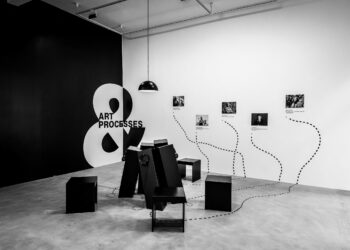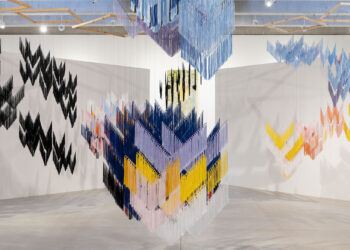Co-organised with IPEAFRO, the exhibition features more than 180 works, including documents, books, and artworks by Nascimento and other artists, including Mestre Didi, Rubem Valentim, Melvin Edwards, Regina Vater, Emanoel Araujo, Hélio Oiticica and Anna Bella Geiger

Abdias Nascimento, Raízes n. 2 Tributo a Aguinaldo Camargo. Rio de Janeiro, 1988. Courtesy of Museu de Arte Negra, Ipeafro.
Over the course of more than two years (2021-2024), in partnership with the Afro-Brazilian Studies and Research Institute (IPEAFRO), Inhotim is hosting a museum on its premises: the Museu de Arte Negra (Black Art Museum), conceived by Abdias Nascimento (1914-2011) in the early 1950s and now under the care of IPEAFRO.
On Saturday, March 18, 2023, as part of this event, the exhibition ‘Terceiro Ato: Sortilégio (Third Act: Sortilege)’, will be inaugurated at Galeria Mata. Sortilégio (Mistério Negro) (/Sortilege (Black Mystery) is the name of the first play written by Abdias, in 1951 a drama significantly marked by the linguistic and symbolic structures of Afro-Diasporic traditions. ‘Third Act: Sortilege’, addresses the artist’s period of exile, between 1968 and 1981, and the dissemination of Brazilian Black art and his own artistic production internationally.
As a playwright and later as a painter, Abdias Nascimento played a political and social role by enabling a paradigm shift for the reconstruction of an African epistemology, using language and symbols from the different Afro-Diasporic traditions. With this in mind, ‘Third Act: Sortilege’ is organised into five thematic nuclei (Contemporary Ritual Symbols; New York: Beginning of Exile; University Professor; Afro-Brazilian Artists;and Orixás: Conception of Life and Philosophy of the Universe) concentrated on Nascimento’s prolific production as a painter, which took place mostly outside Brazil.
“Nascimento maintained his interest in African ancestral traditions as the foundation for his artistic production. Thus, this constant connection to the knowledge systems of Afro-Diasporic religions is at the heart of his thinking as an intellectual and artist”, says Deri Andrade, assistant curator at Inhotim.
Some of the works exhibited in the show are by Brazilian artists who were active in the international art scene, mainly in New York, while Abdias Nascimento was there, reflecting their experiences in a foreign land. The thematic nuclei of the exhibition seek to reaffirm the idea of the Black Art Museum as a collective museum, formed by artists with whom Abdias interacted during his lifetime. The video room shows the documentary Exu Rei – Abdias Nascimento (King Exu – Abdias Nascimento) (2017), by Bárbara Vento, which highlights Abdias Nascimento’s traits of great expressiveness and communication, as well as his dynamism and activism, while dialoguing with the archetype of Exu as a figure of transformation and its influence on Black culture and Brazilian art.
Consisting of artworks on loan – the great majority from IPEAFRO’s Black Art Museum collection -, and recent incorporations to Inhotim’s collection, ‘Third Act: Sortilege’ brings to the public more than 180 works, including works by Abdias Nascimento and other artists such as Mestre Didi, Rubem Valentim, Melvin Edwards, Regina Vater, Manuel Messias, Emanoel Araujo, Hélio Oiticica, Anna Bella Geiger, Anna Maria Maiolino, Iara Rosa, Romare Bearden, LeRoy Clarke, as well as books and research documents consulted by Abdias on Candomblé and the Orixás.
The exhibition features a thematic nucleus dedicated to Exu, the Orixá (deity) present in many of Nascimento’s works. Exu is the Orixá of communication, guardian of paths. “Abdias thinks of the Orixás, ritual symbols, and ancestral languages as points of departure for a Pan-African endeavor. In his work, he recaptures the meaning of Candomblé as a conception of life and philosophy of the universe”, explains Inhotim curator Douglas de Freitas.
In May 1968, during the celebrations of the 80th anniversary of the abolition of slavery, Teatro Experimental do Negro (Black Experimental Theater) held the inaugural exhibition of the Black Art Museum collection at the Museu da Imagem e do Som (Museum of Image and Sound) in Rio de Janeiro. Throughout that year, Abdias Nascimento had significant exchanges with national and international artists, and the Black Art Museum project gained prominence in the media, especially in Correio da Manhã, a newspaper that was opposed to the military regime. At the end of the same year, Abdias Nascimento received a cultural exchange scholarship to the United States. With the promulgation of Institutional Act No. 5, on December 13, 1968, Congress was closed and the most severe phase of violent political repression by the military dictatorship in Brazil began. Nascimento’s political activism had already made him a target of several Military police inquiries, while the intensification of repression placed him at risk of further persecution.
Facing the risk of persecution, torture and murder by the Brazilian government, the artist found himself unable to return to his home country. This fact limited the activities of the Black Art Museum on Brazilian soil, but not those of its curator, who continued to produce and collect works during his exile. During this period, Abdias intensified his activity as a painter, in cities like New York, Middletown, and Buffalo, dialoguing with the landscapes and artistic circles of these places – in his work, we see representations of these geographies and tributes to figures with whom he interacted, like Rubens Gerchman. He also consolidated the presence of African religiosity in his work.
“It is in exile that Abdias Nascimento becomes internationally recognised not only as an artist, but mainly as one of the Brazilian personalities best prepared to confront racism in its aesthetic and structural dimensions. His accumulated experience, which includes his participation in the Frente Negra Brasileira (Brazilian Black Front), in the 1930s, the Black Experimental Theater, the Quilombo newspaper and the creation of the Black Art Museum project, contributed to the consolidation of a life-experience that led him, toward the end of his life, in 2009, to be officially nominated for the Nobel Peace Prize for his body of work”, says Julio Ricardo Menezes Silva, researcher at IPEAFRO and coordinator of IPEAFRO’s Museu de Arte Negra virtual (Virtual Black Art Museum).
‘Third Act: Sortilege’ continues the critical reappraisal of Nascimento’s multiple legacies that have been presented in the preceding exhibitions, Primeiro Ato: Abdias Nascimento, Tunga e o Museu de Arte Negra (First Act: Abdias Nascimento, Tunga and the Black Art Museum) and Segundo Ato: Dramas para negros e prólogo para brancos (Second Act: Dramas for Blacks and Prologue for Whites). Each exhibition examined a particular aspect of his life´s work and multiple contributions as a poet, writer, playwright, curator, visual artist, university professor, pan-Africanist and congressman with a long track record in activism and the fight against racism.
The exhibition will be on view from the 18th of March until the 6th of August, 2023. For more information, please visit Inhotim.



